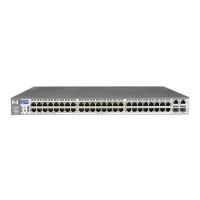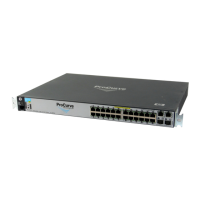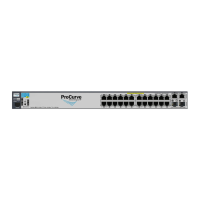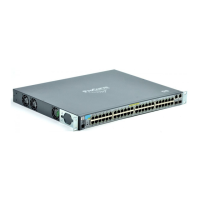12-5
Multimedia Traffic Control with IP Multicast (IGMP)
General Operation and Features
IGMP Operating Features
Basic Operation
In the factory default configuration, IGMP is disabled. If multiple VLANs are
not configured, you must configure IGMP on the default VLAN
(DEFAULT_VLAN; VID = 1). If multiple VLANs are configured, you must
configure IGMP on a per-VLAN basis for every VLAN where this feature is
desired.
Enhancements
With the CLI, you can configure these additional options:
■ Forward with High Priority. Disabling this parameter (the default)
causes the switch or VLAN to process IP multicast traffic, along with other
traffic, in the order received (usually, normal priority). Enabling this
parameter causes the switch or VLAN to give a higher priority to IP
multicast traffic than to other traffic.
■ Auto/Blocked/Forward: You can use the console to configure individual
ports to any of the following states:
• Auto (the default): Causes the switch to interpret IGMP packets and
to filter IP multicast traffic based on the IGMP packet information for
ports belonging to a multicast group. This means that IGMP traffic
will be forwarded on a specific port only if an IGMP host or multicast
router is connected to the port.
• Blocked: Causes the switch to drop all IGMP transmissions received
from a specific port and to block all outgoing IP Multicast packets for
that port. This has the effect of preventing IGMP traffic from moving
through specific ports.
• Forward: Causes the switch to forward all IGMP and IP multicast
transmissions through the port.
■ Operation With or Without IP Addressing: This feature helps to
conserve IP addresses by enabling IGMP to run on VLANs that do not have
an IP address. See “Operation With or Without IP Addressing” on page
12-12.
■ Fast-Leave IGMP: This automatic feature reduces leave delays, which
helps to reduce unnecessary multicast traffic. See “Automatic Fast-Leave
IGMP” on page 12-13.
■ Forced Fast-Leave IGMP: Where a port is connected to multiple end
nodes, this feature speeds up the process of blocking unnecessary IGMP
traffic to the port.
!Software.book Page 5 Thursday, October 10, 2002 6:10 PM

